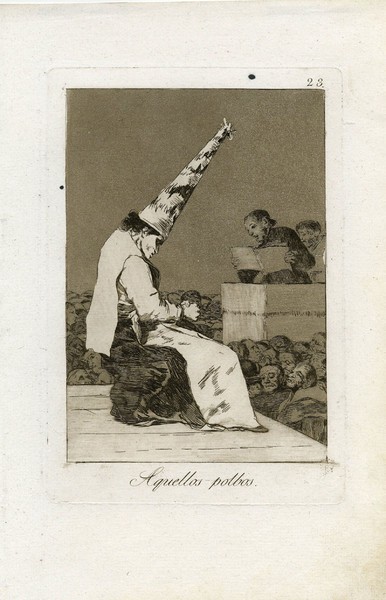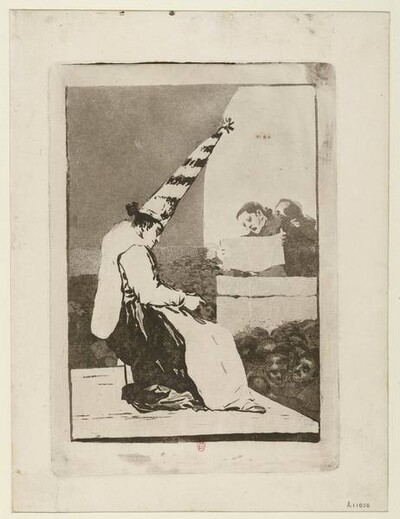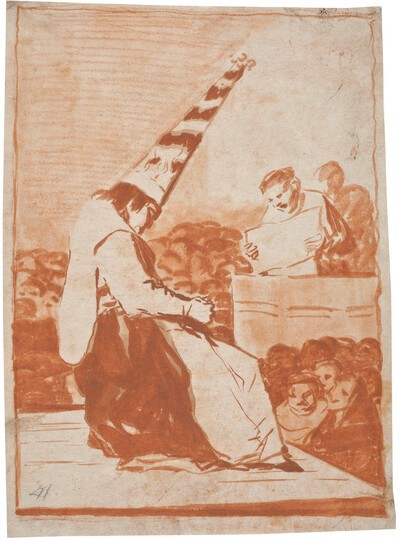- Cronología
- Ca. 1797 - 1799
- Dimensiones
- 219 x 150 mm
- Técnica y soporte
- Aguafuerte, aguatinta bruñida, punta seca y buril
- Reconocimiento de la autoría de Goya
- Undisputed work
- Ficha: realización/revisión
- 30 Nov 2010 / 29 May 2024
- Inventario
- 225
Those powders (in the lower part)
23. (in the upper right-hand corner)
See Francisco de Goya y Lucientes, Painter.
A single state proof is known to exist in the Bibliothèque Nationale de France in Paris, belonging to an early version that was discarded. It has the peculiarity that it is only done with aquatint, although it seems that Goya ended up using the point of the etching in some areas such as the lines of the victim's skirt.
The final version was done in etching; Goya simplified the use of aquatint by using a single tone throughout the background, which allowed him to characterise the figures in the crowd more accurately.
A preparatory drawing for this engraving has survived.
A prisoner - in the Goyaesque engraving it is really difficult to tell whether it is a man or a woman - is seated on a raised platform. He wears a sambenito, a chasuble that was often decorated with scenes alluding to hell, and a coroza on his head. He is being subjected to a singular act of faith that was celebrated with a single prisoner, either inside a church or in a public space. In front of him stands a pulpit from which an inquisitor reads the charges from an open book. Around the pulpit and the stage, a crowd witnesses the trial. We can only make out two friars in the foreground because Goya has superficially and indistinctly captured the rest of the faces.
The explanations in the manuscripts clarify engraving no. 23 of the series; the Ayala engraving reads: " Self-belief. A rabble of foolish priests and friars make a meal of such functions. Perico the lame man who gave powder to lovers. The one in the Prado Museum reads: "Badly done! To treat a woman of honour, who for a frivolous woman served the whole world diligently, in this way is wrong! Finally, the manuscript in the National Library notes that "the rabble of priests and friars is the one who lives with the feasts of the autillos (Perico the lame)".
Goya, as an Enlightenment painter, harshly criticised the autos de fe to which those accused of witchcraft were subjected. The painter finds it difficult to understand how the accounts of witchcraft could be given credibility and, if so, these activities should be judged by the courts and not by the Inquisition.
The somewhat cryptic title may, according to Edith Helman, refer to the popular saying "the dust has turned to mud". In reality, this type of act in which witchcraft is judged is followed by an equally irrational gesture such as the death penalty. Goya demonstrated in some of the engravings in this series, as well as in The Disasters of War, an important awareness of the importance of the death penalty.
The plate is preserved in the National Chalcography (no. 194).
-
Goya. Gemälde Zeichnungen. Graphik. TapisserienKunsthalle BaselBasle1953from January 23th to April 12th 1953cat. 213
-
De grafiek van GoyaRijksmuseum RijksprentenkabinetAmsterdam1970from November 13th 1970 to January 17th 1971cat. 25
-
Goya. Das Zeitalter der Revolucionen. Kunst um 1800 (1980 – 1981)Hamburger KunsthalleHamburg1980cat. 29
-
Goya dans les collections suissesFundación Pierre GianaddaMartigny1982consultant editor Pierre Gassier. From June 12th to August 29th 1982cat. 49
-
Goya. La década de Los CaprichosMadrid1992organized by Real Academia de Bellas Artes de San Fernando sponsored by Fundación Central Hispano, Madrid, consultant editor Nigel Glendinnig. From October 26th 1992 to January 10th 1993cat.94
-
GoyaNationalmuseumStockholm1994consultant editors Juan J. Luna and Görel Cavalli-Björkman. From October 7th 1994 to January 8th 1995cat. 59
-
Francisco de GoyaMuseo d'Arte ModernaLugano1996exhibition celebrated from September 22nd to November 17th.cat. 23, p.50
-
Ydioma universal: Goya en la Biblioteca NacionalBiblioteca NacionalMadrid1996from September 19th to December 15th 1996cat. 142
-
Francisco Goya. Sein leben im spiegel der graphik. Fuendetodos 1746-1828 Bordeaux. 1746-1996Galerie KornfeldBern1996from November 21st 1996 to January 1997cat. 29
-
Francisco Goya. Capricci, follie e disastri della guerraSan Donato Milanese2000Opere grafiche della Fondazione Antonio Mazzottacat. 23, p.25
-
Goya e la tradizione italianaFondazione Magnani RoccaMamiano di Traversetolo (Parma)2006consultant editors Fred Licht and Simona Tosini Pizzetti. From September 9th to December 3th 2006cat. 23, p.151
-
Goya. Opera graficaPinacoteca del Castello di San GiorgioLegnano2006exhibition celebrated from December 16th 2006 to April 1st 2007p.28
-
Goya et la modernitéPinacothèque de ParisParís2013from October 11st 2013 to March 16th 2014cat. 151
-
Goya: Order and disorderMuseum of Fine ArtsBoston2014cat. 205
-
Madrid2017
-
Agen2019cat. 48
-
Hamburg2019cat. 101
-
2022
-
Goya engravings and lithographs, vol. I y II.OxfordBruno Cassirer1964p.93, cat. 58
-
Vie et ouvre de Francisco de GoyaParísOffice du livre1970p.179, cat. 498
-
Goya, la década de los caprichos: dibujos y aguafuertesMadridReal Academia de Bellas Artes de San Fernando1992pp.160-163, cat. 93-95
-
Catálogo de las estampas de Goya en la Biblioteca NacionalMadridMinisterio de Educación y Cultura, Biblioteca Nacional1996p.85, cat. 111
-
El libro de los caprichos: dos siglos de interpretaciones (1799-1999). Catálogo de los dibujos, pruebas de estado, láminas de cobre y estampas de la primera ediciónMadridMuseo Nacional del Prado1999pp.156-159
-
ParísPinacoteca de París2013p. 216
-
Goya: Order & DisorderBostonMuseum of Fine Arts Boston Publications2014p. 300
-
Goya. In the Norton Simon MuseumPasadenaNorton Simon Museum2016pp. 42-75
-
ZaragozaGobierno de Aragón y Fundación Bancaria Ibercaja2017p. 271
-
AgenSnoeck2019p. 152
-
HamburgHirmer2019p. 311
-
Museo de Bellas Artes de Badajoz y Diputación de Badajoz2022p. 37


